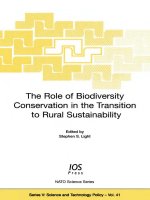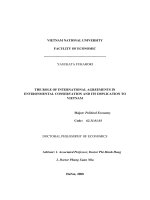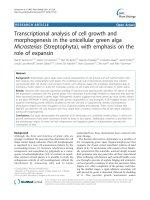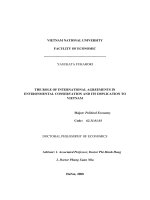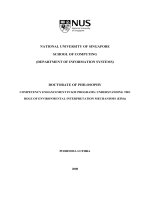Environmental sustainability role of green technologies
Bạn đang xem bản rút gọn của tài liệu. Xem và tải ngay bản đầy đủ của tài liệu tại đây (9.75 MB, 327 trang )
P. Thangavel · G. Sridevi Editors
Environmental
Sustainability
Role of Green Technologies
Tai Lieu Chat Luong
Environmental Sustainability
P. Thangavel • G. Sridevi
Editors
Environmental
Sustainability
Role of Green Technologies
Editors
P. Thangavel
Environmental Science
Periyar University
Salem, TN, India
G. Sridevi
Plant Biotechnology, SBT
Madurai Kamaraj University
Madurai, TN, India
ISBN 978-81-322-2055-8
ISBN 978-81-322-2056-5 (eBook)
DOI 10.1007/978-81-322-2056-5
Springer New Delhi Heidelberg New York Dordrecht London
Library of Congress Control Number: 2014952888
© Springer India 2015
This work is subject to copyright. All rights are reserved by the Publisher, whether the whole or
part of the material is concerned, specifically the rights of translation, reprinting, reuse of
illustrations, recitation, broadcasting, reproduction on microfilms or in any other physical way,
and transmission or information storage and retrieval, electronic adaptation, computer software,
or by similar or dissimilar methodology now known or hereafter developed. Exempted from this
legal reservation are brief excerpts in connection with reviews or scholarly analysis or material
supplied specifically for the purpose of being entered and executed on a computer system, for
exclusive use by the purchaser of the work. Duplication of this publication or parts thereof is
permitted only under the provisions of the Copyright Law of the Publisher’s location, in its
current version, and permission for use must always be obtained from Springer. Permissions for
use may be obtained through RightsLink at the Copyright Clearance Center. Violations are liable
to prosecution under the respective Copyright Law.
The use of general descriptive names, registered names, trademarks, service marks, etc. in this
publication does not imply, even in the absence of a specific statement, that such names are
exempt from the relevant protective laws and regulations and therefore free for general use.
While the advice and information in this book are believed to be true and accurate at the date of
publication, neither the authors nor the editors nor the publisher can accept any legal responsibility
for any errors or omissions that may be made. The publisher makes no warranty, express or
implied, with respect to the material contained herein.
Printed on acid-free paper
Springer is part of Springer Science+Business Media (www.springer.com)
Foreword
The implementation of the principles of sustainability is a world’s challenge
in managing a life-sustaining and environmentally sound global ecosystem.
Sustainability has become the foundation for developing modern environmental management strategies for safely consuming and protecting natural
resources that meet needs of today’s and future generations.
In comparing with conventional agriculture, sustainable agricultural systems include many farming practices that can both maintain crop production
and improve soil environment health, such as uses of organic fertilizers, notill or minimum tillage, polyculture, and biological pest management.
Agriculture sustainability considers the utilization of more renewable energies
including solar, wind, and biofuels and thereby reduces our dependence on
non-sustainable energies (i.e., fossil fuel), inorganic fertilizers, and pesticides
or herbicides. Importantly, sustainable agriculture also contributes significantly to global environmental conservation by the reduction of greenhouse
gas emission, as well as evaluates carbon sequestration in agricultural soils.
Indeed, exploring potential effects of sustainable farming practices on crop
production and environmental protection will help us better understand the
development and management of long-term agricultural sustainability, which
also provides insight into developing other sustainable green technologies.
It has been well demonstrated that reducing agriculture’s carbon footprint in
sustainable agricultural production systems can also be effectively achieved
from within the framework of green technology. Green plants and associated
microbes can be used for environmental cleanup, a biotechnology called phytoremediation. This green technology includes several remediation processes,
such as phytoextraction, phytovolatilization, phytostabilization, and phytodegredation. Phytoremediation technologies have been successfully applied for
cleanup of inorganic- and organic-contaminated water and soils. Plant-based
remediation processes have been well defined for many environmentally important contaminants, including heavy metals, metalloids, macronutrients, and
persistent organic compounds (POPs). However, great effort is still needed to
develop an effective phytomanagement system based upon the principles of
agricultural sustainability. Using plants or trees successfully for field phytomanagement will be a long-term endeavor that requires multidisciplinary
knowledge regarding plant selection, crop management practices, contaminant properties, and soil environmental conditions. Importantly, the production of viable plant products and the development of economically feasible
v
Foreword
vi
remediation systems will encourage more widespread implementation of
an integrated phytomanagement strategy. In this regard, oleaginous plants
(Brassica) planted at phytoremediation field sites produced seed that has been
successfully used to produce biodiesel fuels, while the residual seed meal can
be used for animal feed or soil organic amendment.
To assess the appropriateness of sustainable environmental management
strategies, suitable environmental indicators need to be developed and are
applied for long-term monitoring with the determination of ecological functions, such as biological productivity, diversity, autonomy, and resilience, just
to name a few. In regard to green or plant-based sustainable technologies, it
is important to elucidate and better understand those limiting processes or
parameters that are critical for effective management and long-term sustainability. To this end, more worldwide research will be needed for actively
developing and implementing novel sustainable technologies and strategies
in agricultural production and environmental management, such as biofuels
and green economy. At present time, research continues in developing genetic
engineering technology and its application that could result in economically
efficient and environmentally sustainable biotechnologies, such as hyperaccumulating metals or nutrients or increasing plant’s resistance to pests or
chemicals. However, genetically modified plants will be subjected to special
environmental regulations if they are applied for public or commercial remediation for the sake of protecting human and environmental health. Needless
to say, a global effort will be needed to conduct research in different disciplines for developing long-term sustainability of the global ecosystem.
The different chapters contributed by experienced specialists provide a
unique compilation of the dispersed literature on each topic. By sure, the
readers of the book will benefit from this joint vision of different green
technologies which is currently deployed for sustainable environmental management. Therefore, we believe that this book targets a potentially broad
spectrum of audience at different hierarchical levels ranging from the graduate
students/researchers to policy makers in this field of increasing importance.
US Department of Agriculture
Agricultural Research Service
Parlier, CA, USA
Environmental Sciences Program
Southern Illinois University
Edwardsville, IL, USA
Gary S. Bañuelos, Ph.D
Zhi-Qing Lin, Ph.D
Preface
Sustainable environment is a paradigm for the future in which the four dimensions such as environment, society, culture, and economy are balanced to
improve the quality of life. According to the Brundtland Report, sustainable
development means the development that meets the needs of the present
without compromising the ability of future generations. At the end of 2012,
there were about 7.06 billion people in the world (US Census Bureau 2013)
and it is expected to be more than 10 billion by 2100 (UN 2011). As a result,
there is a need for clean water, food, and environment for all of them, and it
is difficult to take care of everyone with depleted soil and chemical-laden
drinking water. The only solution will be green technology, an eco-friendly
technology which will conserve natural resources and ecosystems. According
to the UNDP report in 2012, over 30 % of the food production goes waste
every year (Gustavsson et al. 2011), but 40 % of the children in Africa who
are below 5 years are malnourished (UNDP 2012). In the United Nations
Conference on Sustainable Development, the “Zero Hunger Challenge” was
launched by the UN Secretary General Ban Ki-Moon where all the countries
will work for the future in which every individual would have adequate nutrition (UNCSD 2012). Sustainable consumption is a better way to reduce the
resource use, degradation, and pollution and increase the quality of human
life. The organizations like UNEP, WHO, and others focus on food waste
reduction and launched the global campaign, “Think.Eat.Save: Reduce Your
Foodprint,” the theme of World Environment Day 2013. In addition, the
World Food Day 2013 also focuses on sustainable food systems for food
security and nutrition.
Renewable energy could account for 77 % of total primary energy supply
by 2050. The past few years have seen a rise in green innovation, and increasing amounts of venture capital are flowing in, with India being rated as the
third most attractive country for renewable energy investment. Green building concept have attracted both the building promoters and end users in terms
of the cost-effective as well as healthy and comfortable living conditions such
as minimum utilization of energy and water, conservation of natural resources
and generates less wastes. According to UNEP (2010), green economy
encompasses all the economic opportunities arising from actions that promote sustainability, improving “human well-being and social equity, while
significantly reducing environmental risks and ecological scarcities.” On the
other hand, the contribution of environmental technologies to growing
vii
Preface
viii
economy is known as “green growth” (OECD 2011). The green economy is
expanding in the European Union and at the global level through clean technologies with green energy produced especially for wind turbines and biofuels.
In addition, the green economy is also used in agricultural sectors such as
different types of plant and animal breeds with high genetic performances,
bioconversion of plant biomass, and green products obtained from bioreactors.
The agricultural wastes and its by-products are mainly used in the production
of heat and power, animal feed, or biogas by anaerobic digestion. Further, it
is known that these materials may also contain high-value compounds such as
antioxidants, pigments, and other molecules of interest. For example, quercetin
extracted from onion waste is a potent antioxidant that has a positive effect
against cancer (Murakami et al. 2008) and cardiovascular (Cook and Samman
1996) and neurodegenerative diseases (Ono et al. 2006).
Recently, most of the research on phyto-/bioremediation aspects have
mainly focused on remediation of contaminated environments at different
levels without affecting soil beneficial flora and fauna. Sustainable agricultural practices such as vermitechniques, biofertilizers, biopesticides, role of
plant growth-promoting bacteria, and AM fungal in phytoremediation will
also enhance the soil quality or soil health status. Suitable hyperaccumulator
plants have also been used for dual benefit purposes such as phytoextraction
and biofortification to solve the nutrient deficiencies especially in staple food
crops. The UN’s fourth World Water Development Report recommended
broader collaborative and integrative water management approaches to avoid
future conflicts over water among nations and, within nations, among farmers,
urbanites, energy producers, environmentalists, and industries.
Green technologies mainly focus on renewable energy sources, sustainable
agricultural practices, phyto-/bioremediation of contaminants, biofuels, sustainable utilization of resources, green buildings, green chemistry, and green
economy. All of these eco-friendly technologies will help to reduce the
amount of waste and pollution and enhance the nation’s economic growth in
a sustainable manner. We hope this book will bring out the recent advancement and application of different green technologies and strategies implemented worldwide and this will pave the way for sustainable environment.
The contents of the book is aimed to provide an integrated approach to sustainable environment, and it will be of interest not only to environmentalists
but also to agriculturists and forest and soil scientists and in bridging the gap
between the scholars/scientists and policymakers.
We personally thank all the contributors of this book who have spent their
valuable time and shared knowledge and enthusiasm. We express our sincere
thanks to all our well-wishers, teachers, research students, and family.
Without their unending support, motivation, and encouragement, the present
grueling task would have never been accomplished. Exceptional kind support
provided by Dr. Mamta Kapila, Raman Shukla, and their team at Springer
deserves praises which made our efforts successful.
Salem, India
Madurai, India
P. Thangavel
G. Sridevi
Preface
ix
References
Cook NC, Samman S (1996) Flavonoids – chemistry, metabolism, cardioprotective effects,
and dietary sources. J Nutr Biochem 7:66–76
Gustavsson J, Cederberg C, Sonesson U, van Otterdijk R, Meybeck A (2011) Global food
losses and food waste – extent, causes and prevention. FAO, Rome
Murakami A, Ashida H, Terao J (2008) Multitargeted cancer prevention by quercetin.
Cancer Lett 269:315–325
OECD (2011) Towards green growth. Organization for Economic Cooperation and
Development, Paris
Ono K, Hamaguchi T, Naiki H, Yamada M (2006) Anti-amyloidogenic effects of antioxidants: implications for the prevention and therapeutics of Alzheimer’s disease. Biochim
Biophys Acta Mol Basis Dis 1762:575–586
UN (2011) U.N. Forecasts 10.1 Billion people by century’s end. The New York Times, 3
May 2011
UNCSD (2012) Rio+20: Secretary-General challenges nations to achieve “zero hunger.”
Media release, 22 June
UNDP (2012) Africa Human Development Report 2012: towards a food secure future.
United Nations Development Programme, New York
UNEP (2010) Green economy developing countries success stories. United Nations
Environment Programme, Geneva
US Census Bureau (2013) Current population clock. United States Department of
Commerce, Washington, DC
Contents
Part I
Sustainable Agriculture
Insight into the Role of Arbuscular Mycorrhizal
Fungi in Sustainable Agriculture .........................................................
P. Priyadharsini and T. Muthukumar
Recycled Water Irrigation in Australia ...............................................
Balaji Seshadri, Nanthi S. Bolan, Anitha Kunhikrishnan,
Saikat Chowdhury, Ramya Thangarajan,
and Thammared Chuasavathi
A Review of Biopesticides and Their Mode
of Action Against Insect Pests ..............................................................
Sengottayan Senthil-Nathan
Seaweeds: A Promising Source for Sustainable Development ..........
T. Nedumaran and D. Arulbalachandran
Part II
3
39
49
65
Renewable Energy
A Comprehensive Overview of Renewable
Energy Status in India ..........................................................................
Atul Sharma, Jaya Srivastava, and Anil Kumar
91
The Sahara Solar Breeder (SSB) Project Contributes
to Global Sustainable Energy Production
and Resource Conservation: An Overview ......................................... 107
A. Boudghene Stambouli and H. Koinuma
Clean Development Mechanism:
A Key to Sustainable Development ..................................................... 121
Himanshu Nautiyal and Varun
Microalgae as an Attractive Source for Biofuel Production.............. 129
S. Ramaraj, S. Hemaiswarya, Rathinam Raja, V. Ganesan,
C. Anbazhagan, Isabel S. Carvalho, and Niran Juntawong
Advancement and Challenges in Harvesting
Techniques for Recovery of Microalgae Biomass............................... 159
Amrita Difusa, K. Mohanty, and V.V. Goud
xi
Contents
xii
Part III
Remediation Technologies
Characterization of Bacillus Strains Producing Biosurfactants ....... 173
Anna Płaza Grażyna, Magdalena Pacwa-Płociniczak,
Zofia Piotrowska-Seget, Robin Brigmon, and Ewa Król
Production of Biosurfactants Using
Eco-friendly Microorganisms .............................................................. 185
Chibuzo Uzoigwe, Christopher J. Ennis,
and Pattanathu K.S.M. Rahman
Eco-Friendly Technologies for Heavy Metal
Remediation: Pragmatic Approaches.................................................. 205
Hemambika Balakrishnan and Rajeshkannan Velu
Phytoextraction of Trace Metals: Principles and Applications ......... 217
Tiziana Centofanti
Integrated Management of Mine Waste
Using Biogeotechnologies Focusing Thai Mines ................................. 229
M.N.V. Prasad and Woranan Nakbanpote
Constructed Wetland: An Ecotechnology
for Wastewater Treatment and Conservation
of Ganga Water Quality ....................................................................... 251
U.N. Rai, A.K. Upadhyay, and N.K. Singh
Mycorrhizal Plants’ Accelerated Revegetation on Coal
Mine Overburden in the Dry Steppes of Kazakhstan ....................... 265
D.V. Veselkin, A.N. Kupriynanov, Ju. A. Manakov,
A.A. Betekhtina, and M.N.V. Prasad
Part IV
Green Economy and Green Nanotechnology
Drivers of Green Economy: An Indian Perspective ........................... 283
Sanjay Kumar Kar, Saroj Kumar Mishra, and Rohit Bansal
Green Nanotechnology: The Solution
to Sustainable Development of Environment ..................................... 311
Rajeshwari Sivaraj, Hasna Abdul Salam,
P. Rajiv, and Venckatesh Rajendran
Contributors
C. Anbazhagan Department of Botany, Annamalai University, Chidambaram,
India
D. Arulbalachandran Department of Botany, Periyar University, Salem,
Tamil Nadu, India
Hemambika Balakrishnan Department of Microbiology, Rhizosphere
Biology Laboratory, School of Life Sciences, Bharathidasan University,
Tiruchirappalli, Tamil Nadu, India
Rohit Bansal Department of Management Studies, NOIDA, Rajiv Gandhi
Institute of Petroleum Technology, Rae Bareli, Uttar Pradesh, India
A.A. Betekhtina Department of Ecology, Ural Federal University (UrFU),
Yekaterinburg, Russia
Nanthi S. Bolan Centre for Environmental Risk Assessment and
Remediation (CERAR), University of South Australia, Adelaide, SA,
Australia
Cooperative Research Centre for Contamination Assessment and Remediation
of the Environment (CRC CARE), University of South Australia, Adelaide,
SA, Australia
Robin Brigmon Savannah River National Laboratory, Aiken, SC, USA
Isabel S. Carvalho Food Science Laboratory, IBB/CGB, University of
Algarve, Gambelas, Faro, Portugal
Tiziana Centofanti Department of Plant Science, California State
University-Fresno, Fresno, CA, USA
Saikat Chowdhury Department of Soil Science, Sher-e-Bangla Agricultural
University, Dhaka, Bangladesh
Thammared Chuasavathi Division of Land Resources and Environment
Section, Department of Plant Sciences and Agricultural Resources, Faculty of
Agriculture, KhonKaen University, KhonKaen, Thailand
Amrita Difusa Centre for Energy, Indian Institute of Technology Guwahati,
Guwahati, Assam, India
xiii
xiv
Christopher J. Ennis School of Science and Engineering, Teesside
University, Middlesbrough, UK
V. Ganesan ACME Progen Biotech (India) Pvt. Ltd., Salem, India
V.V. Goud Centre for Energy, Indian Institute of Technology Guwahati,
Guwahati, Assam, India
Department of Chemical Engineering, Indian Institute of Technology
Guwahati, Guwahati, Assam, India
S. Hemaiswarya Food Science Laboratory, IBB/CGB, University of
Algarve, Gambelas, Faro, Portugal
Niran Juntawong Bioscience Program, Faculty of Science, Kasetsart
University, Bangkok, Thailand
Department of Botany, Faculty of Science, Kasetsart University, Bangkok,
Thailand
Center for Advanced Studies in Tropical Natural Resources, National
Research University-Kasetsart University (CASTNAR, NRU-KU),
Kasetsart University, Bangkok, Thailand
Sanjay Kumar Kar Department of Management Studies, NOIDA, Rajiv
Gandhi Institute of Petroleum Technology, Rae Bareli, Uttar Pradesh, India
H. Koinuma Graduate School of Frontier Sciences, Tokyo University,
National Institute for Materials Science, Ibaraki, Japan
Ewa Król Department of Phytopathology and Mycology, University of Life
Sciences, Lublin, Poland
Anil Kumar Department of Energy, Maulana Azad National Institute of
Technology, Bhopal, Madhya Pradesh, India
Anitha Kunhikrishnan Chemical Safety Division, Department of AgroFood Safety, National Academy of Agricultural Science, Wanju-gun, Republic
of Korea
A.N. Kupriynanov Siberian Division, Institute of Human Ecology, Russian
Academy of Sciences, Kemerovo, Russia
Ju. A. Manakov Siberian Division, Institute of Human Ecology, Russian
Academy of Sciences, Kemerovo, Russia
Saroj Kumar Mishra Department of Management Studies, NOIDA, Rajiv
Gandhi Institute of Petroleum Technology, Rae Bareli, Uttar Pradesh, India
K. Mohanty Centre for Energy, Indian Institute of Technology Guwahati,
Guwahati, Assam, India
Department of Chemical Engineering, Indian Institute of Technology
Guwahati, Guwahati, Assam, India
T. Muthukumar Root and Soil Biology Laboratory, Department of Botany,
Bharathiar University, Coimbatore, Tamil Nadu, India
Contributors
Contributors
xv
Woranan Nakbanpote Department of Biology, Faculty of Science,
Mahasarakham University, Khamriang, Kantarawichi, Mahasarakham,
Thailand
Himanshu Nautiyal Department of Mechanical Engineering, THDC
Institute of Hydropower Engineering & Technology, Tehri Garhwal,
Uttarakhand, India
T. Nedumaran Department of Plant Biology and Plant Biotechnology, Sir
Theagaraya College, Chennai, Tamil Nadu, India
Magdalena Pacwa-Płociniczak Department of Microbiology, University of
Silesia, Katowice, Poland
Zofia Piotrowska-Seget Department of Microbiology, University of Silesia,
Katowice, Poland
Anna Płaza Grażyna Department of Environmental Microbiology, Institute
for Ecology of Industrial Areas, Katowice, Poland
Faculty of Organisation and Management, Institute of Production Engineering,
Silesian University of Technology, Zabrze, Poland
M.N.V. Prasad Department of Plant Sciences, University of Hyderabad,
Hyderabad, Andhra Pradesh, India
P. Priyadharsini Root and Soil Biology Laboratory, Department of Botany,
Bharathiar University, Coimbatore, Tamil Nadu, India
Pattanathu K.S.M. Rahman School of Science and Engineering, Teesside
University, Middlesbrough, UK
U.N. Rai Plant Ecology and Environmental Science Division, CSIR-National
Botanical Research Institute, Lucknow, India
Rathinam Raja Food Science Laboratory, IBB/CGB, University of Algarve,
Gambelas, Faro, Portugal
Venckatesh Rajendran Department of Chemistry, Government Arts
College, Udumalpet, Tamil Nadu, India
P. Rajiv Department of Biotechnology, School of Life Sciences, Karpagam
University, Coimbatore, Tamil Nadu, India
S. Ramaraj Bioscience Program, Faculty of Science, Kasetsart University,
Bangkok, Thailand
Center for Advanced Studies in Tropical Natural Resources, National
Research University-Kasetsart University (CASTNAR, NRU-KU), Kasetsart
University, Bangkok, Thailand
Hasna Abdul Salam Department of Biotechnology, School of Life Sciences,
Karpagam University, Coimbatore, Tamil Nadu, India
xvi
Sengottayan Senthil-Nathan Division of Biopesticides and Environmental
Toxicology, Sri Paramakalyani Centre for Excellence in Environmental
Sciences, Manonmaniam Sundaranar University, Alwarkurichi, Tirunelveli,
Tamil Nadu, India
Balaji Seshadri Centre for Environmental Risk Assessment and
Remediation (CERAR), University of South Australia, Adelaide, SA,
Australia
Cooperative Research Centre for Contamination Assessment and Remediation
of the Environment (CRC CARE), University of South Australia, Adelaide,
SA, Australia
Atul Sharma Non Conventional Energy Laboratory, Rajiv Gandhi Institute
of Petroleum Technology (RGIPT), Rae Bareli, Uttar Pradesh, India
N.K. Singh Plant Ecology and Environmental Science Division, CSIRNational Botanical Research Institute, Lucknow, India
Rajeshwari Sivaraj Department of Biotechnology, School of Life Sciences,
Karpagam University, Coimbatore, Tamil Nadu, India
Jaya Srivastava Department of Management Studies, Rajiv Gandhi Institute
of Petroleum Technology (RGIPT), Rae Bareli, Uttar Pradesh, India
A. Boudghene Stambouli University of Science and Technology of Oran,
USTO-MB, Oran, Algeria
Ramya Thangarajan Centre for Environmental Risk Assessment and
Remediation (CERAR), University of South Australia, Adelaide, SA,
Australia
Cooperative Research Centre for Contamination Assessment and Remediation
of the Environment (CRC CARE), University of South Australia, Adelaide,
SA, Australia
A.K. Upadhyay Plant Ecology and Environmental Science Division, CSIRNational Botanical Research Institute, Lucknow, India
Chibuzo Uzoigwe School of Science and Engineering, Teesside University,
Middlesbrough, UK
Varun Department of Mechanical Engineering, National Institute of
Technology, Hamirpur, Himachal Pradesh, India
Rajeshkannan Velu Department of Microbiology, Rhizosphere Biology
Laboratory, School of Life Sciences, Bharathidasan University,
Tiruchirappalli, Tamil Nadu, India
D.V. Veselkin Institute Plant and Animal Ecology, Ural Division, Russian
Academy of Sciences, Yekaterinburg, Russia
Department of Ecology, Ural Federal University (UrFU), Yekaterinburg,
Russia
Contributors
About the Editors
Dr. P. Thangavel is an Assistant Professor in the Department of
Environmental Science, Periyar University, Salem, Tamil Nadu, India. His
area of specialization is soil ecology and phytoremediation, biofortification,
and biofuels. After his doctoral program in environmental sciences in 2002
at Bharathiar University, he has worked as a visiting scientist/postdoctoral
research associate in the United States Department of Agriculture (USDA),
Forest Service, Durham, New Hampshire, USA, and Sun Yat-sen University,
Guangzhou, PR China. His postdoctoral research is on phytochelatins and
polyamines in metal detoxification mechanism in various tree/hyperaccumulator species using high-performance liquid chromatography (HPLC). He
has been keen to widen his academic attainments, and to his credit he has
published more than 40 original research articles/book chapters in reputed
national and international journals and participated in 75 conferences.
Further, he served as an editorial board member and reviewer for many journals and book chapters. He has professional affiliation with several academic
bodies including ASPB-USA, ESA-USA, ISES-USA, PHYTONET-Italy,
INSCR-New Delhi, ISEB-Lucknow, and ISCA-Kolkata.
Dr. G. Sridevi is an Assistant Professor in the Department of Plant
Biotechnology, School of Biotechnology, Madurai Kamaraj University,
Madurai, Tamil Nadu, India. Her area of specialization is plant molecular
biology, metagenomics, and RNA silencing. Earlier, she has worked as postdoctoral researcher in the University of New Hampshire, USA, and South
China Agricultural University, Guangzhou, PR China. She has published
many research articles in reputed national and international journals. Further,
she also contributed book chapters in Springer and CRC Press.
xvii
Part I
Sustainable Agriculture
Insight into the Role of Arbuscular
Mycorrhizal Fungi in Sustainable
Agriculture
P. Priyadharsini and T. Muthukumar
Abstract
Sustainable agriculture plays a vital role in agroecosystems and reduces
adverse effects on the environment by utilizing the various natural processes. Optimum soil fertility is an essential goal to be achieved in sustainable agriculture system. The presence of beneficial microorganisms in the
rhizospheric region and their activities are the main focal point which
makes dynamic resources available to plants and conserve soil fertility.
Majority of the agricultural and horticultural crops are associated with
common soil fungi, the arbuscular mycorrhizal (AM) fungi. These fungi
are crucial for plant health and fitness as they increase the efficiencies of
the plant root systems. The hyphae of these fungi originating from roots
grow into the soil and absorb nutrients especially phosphorus and deliver
it to the roots. They also play a crucial role in imparting tolerance to plants
against various stresses as well as modifying soil structure. Nevertheless,
several agricultural practices involved in crop production can influence
both AM formation and function. Consequently, AM fungal introductions
or changes in crop management practices that enhance the proliferation,
diversity and function of native AM fungi become essential. Optimization
of agronomic practices that sustain maximum AM fungal presence and
activity would enable to achieve increased plant production in sustainable
agriculture.
Keywords
Sustainable agriculture • Arbuscular mycorrhizal fungi • Nutrients • Stress
tolerance • Inoculum production
1
P. Priyadharsini • T. Muthukumar (*)
Root and Soil Biology Laboratory, Department of
Botany, Bharathiar University,
Coimbatore 641 046, Tamil Nadu, India
e-mail:
Introduction
In spite of the universal escalation of agriculture
and tremendous growth in the major crop productivity over the last decades, the eradication of
P. Thangavel and G. Sridevi (eds.), Environmental Sustainability,
DOI 10.1007/978-81-322-2056-5_1, © Springer India 2015
3
P. Priyadharsini and T. Muthukumar
4
hunger facing mankind is far from being realized
(FAO 2004). Factors that deter maximum crop
productivity include several abiotic and biotic
stresses like unfavourable climate, drought, diseases and pests. Recently, increased crop productivity has been achieved through crop breeding
along with huge input of chemicals in the form of
fertilizers and biocides. These chemicals not only
disturb agricultural ecosystems but are also detrimental to the environment (Chapin et al. 2000;
Barabasz et al. 2002; Parmesan and Yohe 2003;
Zhong and Cai 2007). The tolerance of crops to
various abiotic and biotic stresses can also be
evolved through the exploitation of the worldwide abundant endophytic associations, where
microorganisms live in reciprocally beneficial
relationship with plants.
Sustainable agriculture, by definition, is ecologically sound, economically viable, and
socially responsible (Siddiqui and Pichtel
2008). Agroecosystems are characterized by
major dependence on human interference and
therefore are influenced by factors that extend
into the system such as energy, agrochemicals
and their residues (Odum 1984). In contrast to
natural ecosystems, agroecosystems are created
and controlled by humans through the management of ecological processes for production and
conservation. Soil is the prime area for manipulation in agroecosystems, because it is a biologically dynamic resource. Within this soil, the
rhizosphere is the locus of greater role of energy
flow and mineral cycling among the physical,
chemical and biological components; it can
therefore be considered as a subsystem (Wright
and Miller 1994).
Arbuscular mycorrhizal (AM) fungi are one
of the imperative soil microorganisms that
participate mainly in the plant uptake of nutrients, especially phosphorus (P) in diverse agroecosystems (Atkinson et al. 2002; Gadd 2005;
Jansa et al. 2008). In addition, AM fungi can
easily take up and translocate other macronutrients and several micronutrients to plants (Ortas
and Akpinar 2006; Abo-Rekab et al. 2010).
Hence, AM fungi are recipients of worldwide
attention as they play an important role in sustaining an active and diverse biological community
essential for increasing the sustainability of
agricultural systems (Gianinazzi and Schüepp
1994). Arbuscular mycorrhizal fungi constitute
around 50 % of soil microbial biomass in agricultural soils due to their profuse growth and
abundance (Olsson et al. 1999). Most of the
major crops are capable of forming AM associations naturally and are the most common mycorrhizal type involved in agricultural systems
(Barea et al. 1993). As AM fungal association
can improve plant growth and health, there is an
increasing interest in ascertaining their effectiveness in plant production systems and, consequently, in manipulating them when feasible, so
that they could be successfully incorporated into
plant production systems.
The aim of this review is to discuss the developments and to provide insights regarding the
potentials of AM fungi in agricultural systems.
Given the overview of beneficial effects of AM
association on plant growth and health, it is
expected that the development of appropriate
management practices that enable the proliferation of AM fungi would reduce the chemical
inputs (fertilizers and biocides) in the upcoming
years, a key aspect of sustainable agriculture.
2
General Aspects
The obligate endosymbiont, ‘AM fungi’ associating
with more than 90 % of terrestrial plants (Graham
2008), belongs to the phylum Glomeromycota
and acts as a bridge between soil and plants.
Arbuscular mycorrhizal fungal hyphae are coenocytic and aseptate and reproduce asexually by
spores (Kuhn et al. 2001). Formerly called ‘vesicular–arbuscular mycorrhiza’ or ‘VAM’, the name
implies to the production of special structures,
i.e. arbuscules and vesicles (Fig. 1), within the
host roots. However, the lack of the production of
vesicles within the host roots by certain genera
belonging to the order Gigasporales (Gigaspora,
Scutellospora) resulted in the modification of
term to ‘arbuscular mycorrhiza’ or ‘AM’. At present, there are around 249 species in 17 genera of
fungi involved in AM association (Schüβler and
Walker 2010).
Insight into the Role of Arbuscular Mycorrhizal Fungi in Sustainable Agriculture
5
Fig. 1 (a–e) Arbuscular mycorrhizal colonization in crop
plants. (a) Surface runner hyphae (rh) on root of Allium
cepa. (b) Appressorium (ap) and hyphal entry in Zea
mays. (c) Intracellular hyphal coils (hc) in Capsicum ann-
uum. (d) Arbuscules (a) and arbuscular trunks (black
arrows) in cortical cells of A. cepa. e Vesicle (v) in root of
Z. mays. Scale bars = 50 μm
Like many host–microbe interactions, the colonization process begins with an exchange of signals between the two partners (host and the
fungus), followed by the development of the
symbiosis. The association is characterized by
the adhesion and ingress of the fungus towards
the host tissue. The host plant provides carbon
source, the photosynthates to the fungus, whereas
in turn, the extraradical hyphae of the fungus
make available the soil nutrients that are not
assessable to plant roots or to the host plant
(Smith and Read 2008). The colonization of the
root by an AM fungus begins with the fixation of
the runner hyphae on the rhizoplane of a susceptible host through an appressorium (Fig. 1a, b).
The AM fungal mycelium has dual phase: extraradical phase characterized by soil hyphae and
intraradical phase characterized by exchange
structures. The former is distinguished morphologically into two types: The first type is the runner hyphae (Fig. 1a) that actively transport
nutrients and spread the hyphal network across
the rhizospheric region extending the association
to nearby plants (Smith and Read 2008; Neumann
and George 2010). The second type is the finely
branched fungal hyphae that play an important
role in the uptake of nutrients from the soil.
Intraradical phase consisting of intraradical
hyphae, arbuscules and vesicles (Fig. 1c–e) plays
an important role in nutrient exchange and uptake
P. Priyadharsini and T. Muthukumar
6
Fig. 2 Arbuscular mycorrhizal fungal structures showing Arum- and Paris-types
of carbon by the fungus. First, the AM hyphae
receive suitable signals from host roots in the
form of root exudates, and most specifically
strigolactones (Akiyama et al. 2005; López-Ráez
et al. 2008), which results in the branching of the
hyphae. In response, the branched hyphae secrete
a diffusible signal to the host roots, which initiates
the expression of symbiotic-related genes (Kosuta
et al. 2003). Based on the distribution of AM fungal structures within the roots, AM colonization
patterns within host roots are divided into three
types: Arum-, Paris- and intermediate-types
(Dickson 2004).
In the Arum-type, the hyphae grow intercellularly in the root cortex and penetrate to form
‘arbuscules’ intracellularly, whereas in Paris-type
association, intracellular hyphal coils frequently
having intercalary arbuscules spread cell to cell
in the cortex (Fig. 2). Intermediate-type AM
exhibits characteristics of both Arum- and Paristypes. Most of the cultivated crops form Arum
type, while Paris-type is common in plants of
natural ecosystem (Ahulu et al. 2005).
Though most agricultural crops such as flax
(Linum usitatissimum), corn (Zea mays), rice
(Oryza sativa), sorghum (Sorghum bicolor),
wheat (Triticum aestivum), barley (Hordeum
vulgare), potato (Solanum tuberosum), sugarcane
(Saccharum officinarum), tomato (Lycopersicon
esculentum) and sunflower (Helianthus annuus)
can benefit from mycorrhizal association, certain
crops belonging to Amaranthaceae, Brassicaceae
and Chenopodiaceae do not form AM symbiosis
(Brundrett 2009).
A wide range of AM fungi have been found to
be associated with crop species (Fig. 3). In spite of
the general assumption that the diversity of AM
fungi is low in agricultural soils, several studies
have reported high AM fungal diversity in agricultural soils (Jansa et al. 2002; Oehl et al. 2003, 2004;
Ambili et al. 2012). Many studies on the diversity
of AM fungi in agricultural soils have indicated the
dominance of AM fungal communities by species
belonging to the genus Glomus or the species that
were once under Glomus (Jansa et al. 2002;
Muthukumar and Udaiyan 2002; Sjoberg et al.
2004; Mathimaran et al. 2005). Nevertheless,
spores of AM fungi belonging to Acaulospora,
Entrophospora, Gigaspora, Sclerocystis and
Scutellospora have also been reported along with
Glomus in agricultural soils (Jansa et al. 2002;
Muthukumar and Udaiyan 2002).
Insight into the Role of Arbuscular Mycorrhizal Fungi in Sustainable Agriculture
Fig. 3 (a–h) Spores of arbuscular mycorrhizal fungi
associated with Eleusine coracana. (a) Spore of
Acaulospora scrobiculata. (b) Loose cluster of Glomus
aggregatum. (c) Funneliformis geosporum. (d)
7
Rhizophagus fasciculatus. (e) Rhizophagus intraradices.
(f) Funneliformis mosseae. (g) Sclerocystis sinuosa (pe
peridium, sp spore). (h) Scutellospora calospora. Scale
bars = 50 μm
P. Priyadharsini and T. Muthukumar
8
3
Effects of AM Fungi
The major effects of AM association on host
plants include enhanced uptake of low-mobile
ions, nutrient cycling, rooting and plant establishment, plant tolerance to various biotic and
abiotic stresses, improved soil quality and
structure and enhanced plant community diversity. In agricultural ecosystems, AM fungi play
a vital role in maintaining sustainability
(Sanders 2004), by enhancing crop growth
(Meir et al. 2010) and productivity (Lekberg
and Koide 2005), soil constituents and fertility
(Piotrowski et al. 2004; Li et al. 2007) and
pathogen resistance (Sikes et al. 2009).
3.1
Improved Nutrient Uptake
and Nutrient Cycling
Arbuscular mycorrhizal fungi improve plant
uptake of nutrients by increasing the plant surface area of absorption. The narrow diameter of
the absorbing hyphae allows more nutrients to be
taken up from the soil solution. Generally, nutrient depletion zones develop around the root when
the nutrients are removed from the soil solution
by the plant roots (Fig. 4). For poorly mobile ions
such as phosphate, a sharp and narrow depletion
zone develops very close to the root. Hyphae of
AM fungi can readily spread beyond this depletion zone and take up additional phosphate from
the soil (Li et al. 1991) (Fig. 4). The uptake of
other nutrients like N, K and micronutrients is
also improved by AM fungi because many of
these elements are also limited due to various
reasons in the soil.
Two important factors that contribute to the
effective uptake of nutrients by AM fungi from
the soil are (i) the narrow diameter of the fungal
hyphae and (ii) its longer lifespan relative to root
and root hairs. As the diffusion gradient for a
nutrient is inversely related to the radius of the
absorbing unit, the soil solution should be less
depleted at the surface of a narrow absorbing unit
such as hyphae. Further, narrow hyphae can also
grow into small soil pores that are not accessible
to roots and root hairs (O’Keefe and Sylvia
1991). Therefore, crop species with welldeveloped root systems with fine roots or abundant root hairs like wheat, barley and oats (Avena
sativa) remains little affected by AM colonization (Ryan and Graham 2002).
Fig. 4 Arbuscular mycorrhizal fungal hyphae and nutrient depletion zones around root


